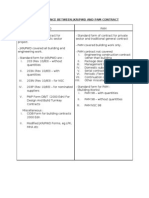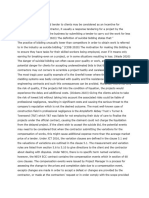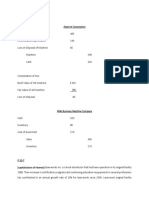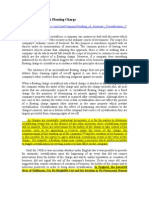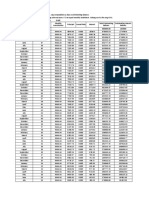Retention Money
Retention Money
Uploaded by
ola789Copyright:
Available Formats
Retention Money
Retention Money
Uploaded by
ola789Copyright
Available Formats
Share this document
Did you find this document useful?
Is this content inappropriate?
Copyright:
Available Formats
Retention Money
Retention Money
Uploaded by
ola789Copyright:
Available Formats
Your Contractual Questions Answered.
Entrusty Group, a multi-displinary group of companies, of which, one of their specialisation is in project, commercial and contractual management, has been running a regular contractual questions and answers section for Master Builders members in the Master Builders Journal. In this instalment of this series, Entrusty Group will provide the answer to the frequently asked question - Should retention sum be placed under a separate bank account ?
ost standard forms of construction / building contract have a provision for the
retention of a certain percentage of the amount due to the Contractor. The main purpose of retention monies is to serve as a protection mechanism for the Employer from the Contractors failure or default in his performance under the contract e.g. rectification of defective work. However, the retention monies are normally to be held by the Employer fiduciary as trustee for the Contractor. The said monies belong to the Contractor and the Employer only holds the retention monies in trust. Usually, the retention amounts often not exceeding ten (10) percent and is limited to five (5) percent of the contract sum
Standard Forms of Contract (Relevant Clauses)
PAM Form of Building Contract PAM 69 Clause 30 (3) & (4) and PAM 98 Clause 30.4 and 30.5 deals with retention fund and its applicable rules. Both forms stipulate in similar wordings that, the Employers interest in any amounts so retained shall be fiduciary as trustee for the Contractor (but without obligation to invest). The monies so retained belong beneficially to the contractor. It further states that the Employer has the right to deduct from such sum due or to become due to the Contractor from payment of any amount he is entitled under the provisions of this Contract, as certified by the Architect. There is no express clause under the PAM form providing for the placement of the retention sums under separate bank account. However, based upon recent case law precedence, it would appear that the Employer should and if not, can be compelled by Court, to place the retention monies under separate bank account. (Refer to Relevant Case Law section below.)
JKR/PWD Form of Contract (203A Rev 10/83) There is no provision for retention monies under JKR Form.
MBAMQuest5
1/4
However, Clause 37 obliges the Contractor to deposit a Performance Bond with the Government, equal to five percent of the contract sum for due observance and performance of the contract. The Government or SO can utilise the said Bond to make payments or deductions from it if the Contractor fails to execute the contract or commits breach of his obligations under the contract.
IEM Conditions of Contract Clause 30(3) and (4) deal with retention monies. The provision for retention monies under IEM Form is similar to PAM.
CIDB Form of Contract for Building Works Clause 42.3 deals with retention monies. Sub-clause 42.3 (c) (ii) states clearly that the Retention Monies shall be placed in a separate banking account designated as being held by the Employer. It further requires the Employer to provide statement of the said account to the Contractor when making payments on interim certificates. It entitles the Employer to full benefits of any interest accrued in the said account, without having to account for it to the Contractor. Like the PAM form, sub-clause 42.3 (c)(iii), it allows the Employer the right to deduct any amounts certified by SO for deduction from the Retention Monies, which only arises after it is due for release or after the determination of the Contractors employment. It is worth noting that the bank should be informed in writing that the monies so placed in separate account are held on trust on behalf of the Contractor, the beneficiary.
Relevant Case Law
In the case Rayack Construction Ltd v Lampeter Meat Co Ltd (1979) 12 BLR 30, it was held that clause 30(4) under JCT 63 (similar to PAM 69) required the Employer to establish a separate trust account to protect the interest of the contractor. The Rayack case was also cited in the Malaysian case, Lee Kam Chun v Syarikat Kukuh Maju Sdn Bhd (1988) 1 CLJ52 in which Peh Swee Chin J with approval on retention matter. In another case, Wates Construction (London) Ltd v Franthom Properties Ltd(1991) 53 BLR 23 the Court of Appeal upheld Judge Neweys (as Official Referee) decision that the Employer should have deposited the retention monies in a separate bank account, as provided in the contract, when he granted the injunctive relief sought by the Contractor to compel the Employer for failing to do so. Citing Newey J :the only way in which the interest of the beneficiaries (the contractor and subcontractors) in the retention fund could be safeguarded and preserved is if that fund is
MBAMQuest5 2/4
placed in a separate account and is not used for the purpose of the employers business or hazarded it in any other way In another Malaysian case, Arab-Malaysian-Toda Construction Sdn Bhd v Shencourt Sdn Bhd (1999) MLJU249 Azmel J was also persuaded by the Rayacks and Wates cases in his decision requiring the Defendant to make payment of the retention money to a separate bank account. The contract was PAM Form, with reference made to clause 30 (4). In EMore Builder Sdn Bhd v Krisari Sdn Bhd (1998) - unreported Shim J in allowing application by Originating Summon to set aside the retention money in separate account, adopted in support, the following cited cases ; Rayack Construction Ltd v Lampeter Meat Co Ltd (1979) 12 BLR 30 Wates Construction (London) Ltd v Franthom Properties Ltd(1991) 53 BLR 23 J F Finnegan Ltd v Ford Stellar Moris Development Ltd (1991) 53 BLR 42, and Lee Kam Chun v Syarikat Kukuh Maju Sdn Bhd (1988) 1 CLJ52 However in a recent Malaysian case Teknik Cekap Sdn Bhd v Villa Genting Development (2000) 6MLJ 513 Abdul Malik Ishak J held that the condition set out in the PAM contract were not applicable and the provisions of clause 30 (4) did not bind the parties at all. Also there was no obligation to set aside any retention monies in separate identifiable account. It must be noted that in this case circumstances (procuring the contract by fraud, dishonest breach of trust, etc) giving rise to the aforesaid decision, which may appear to contradict the other cases.
Conclusion
All construction / building contracts in Malaysia, apart from the PWD203 form, allows the Employer to retain a certain percentage of the monies due to the Contractor as a form of protection from the Contractor defaulting from his obligations under the contract. All retention monies are only held in trust by the Employer on behalf of the Contractor and the monies so held belongs to the Contractor as the beneficiary. Although it is not specifically stated in the PAM and IEM forms, the retention monies should be placed in a separate bank account and should not be used by the Employer for any other purpose.
The next issue will be providing the answer to the question, When must retention
sum be released and paid ?
The Entrusty Group includes Entrusty Consultancy Sdn Bhd (formerly known as J.D. Kingsfield (M) Sdn Bhd), BK Burns & Ong Sdn Bhd, Pro-Value Management and Proforce Management Services Sdn Bhd. Apart from project, commercial and contractual management services, the group also provides risk, resources, quality and value management and recruitment consultancy services to various industries, particularly in construction and petrochemical, both locally and internationally. Entrusty Group is currently running a modular course on Practical Construction Contract Administration/Management. The coming modules are :-
MBAMQuest5
3/4
Topic
Date Saturday Time 9.00am 1.00pm Payment Claims, Valuations, Certifications and Final 28 June 2003 Account
Certificate of Practical Completion and Certificate of 12 July 2003 Making Good Defects Extension of Time and Loss & Expense Nominated Sub-Contractors and Suppliers Domestic Sub-Contractors and Suppliers Determiniation and Dispute Resolution 9 August 2003 26 July 2003 23 August 2003 6 September 2003
Those interested can obtain further information from Candy Kwan at the contact details as listed below. Entrusty Group will provide a 30 minutes of free consultancy with prior appointment to MBAM members on their contractual questions. Kindly contact HT Ong or Wing Ho at 222 Jalan 2/109E, Desa Business Park, Taman Desa, 58100 Kuala Lumpur, Malaysia. Tel: 6(03)-7982 2123 Fax: 6(03)-7982 3122 Email: ntrusty@entrusty.com.my
MBAMQuest5
4/4
You might also like
- Robert Kiyosaki The Real Book of Real Estate94% (16)Robert Kiyosaki The Real Book of Real Estate256 pages
- LAM TIAN SUI-PROFILING OF VALID AVAILABLE GROUNDS To Claim EOTNo ratings yetLAM TIAN SUI-PROFILING OF VALID AVAILABLE GROUNDS To Claim EOT155 pages
- Nirwana Construction SDN BHD V Pengarah Jaba0% (1)Nirwana Construction SDN BHD V Pengarah Jaba30 pages
- Chapter 1 Contract and Estimating Politeknik80% (5)Chapter 1 Contract and Estimating Politeknik29 pages
- Verification of Cash Payment To SubscriptionNo ratings yetVerification of Cash Payment To Subscription2 pages
- 3 Completion, Damages For Non-Completion - Partial Occupation - Defects After CompletionNo ratings yet3 Completion, Damages For Non-Completion - Partial Occupation - Defects After Completion46 pages
- Kerajaan Malaysia (Jabatan Kerja Raya) V Global Globe (M) SDN BHD100% (6)Kerajaan Malaysia (Jabatan Kerja Raya) V Global Globe (M) SDN BHD26 pages
- Termination of Contractor - Sr. Amran Bin Mohd Majid100% (2)Termination of Contractor - Sr. Amran Bin Mohd Majid39 pages
- Must The Contractor Submit His Interim Payment Claims Before The Superintending Officer Certifies For Payment?No ratings yetMust The Contractor Submit His Interim Payment Claims Before The Superintending Officer Certifies For Payment?8 pages
- Syarikat Binaan Utara Jaya V Koperasi Serbaguna Sungai Glugor BHDNo ratings yetSyarikat Binaan Utara Jaya V Koperasi Serbaguna Sungai Glugor BHD31 pages
- BTQS 3034 - Measurement of Civil Engineering Works LECTURE 1bNo ratings yetBTQS 3034 - Measurement of Civil Engineering Works LECTURE 1b54 pages
- Berjaya Times Square SDN BHD V M Concept SDN BHDNo ratings yetBerjaya Times Square SDN BHD V M Concept SDN BHD4 pages
- Kertas Pembentangan 3 - Spesifikasi Teknikal Pengurusan Fasiliti Dan Penyenggaraan Bangunan100% (1)Kertas Pembentangan 3 - Spesifikasi Teknikal Pengurusan Fasiliti Dan Penyenggaraan Bangunan59 pages
- Standard Chart of Accounts For CooperativesNo ratings yetStandard Chart of Accounts For Cooperatives25 pages
- Sunissa V Kerajaan Malaysia - 25mar2021 - Rev1100% (1)Sunissa V Kerajaan Malaysia - 25mar2021 - Rev181 pages
- Target Resources SDN BHD V Putrajaya Holdings SDN BHDNo ratings yetTarget Resources SDN BHD V Putrajaya Holdings SDN BHD11 pages
- The Impact of The Construction Industry Payment and Adjudication Act 2012 On Government Contract Administration (S)100% (1)The Impact of The Construction Industry Payment and Adjudication Act 2012 On Government Contract Administration (S)28 pages
- Sykt Pembinaan Anggerik SDN BHD V Malaysia Airports Holdings BHDNo ratings yetSykt Pembinaan Anggerik SDN BHD V Malaysia Airports Holdings BHD125 pages
- Pec2217n2 Individual Assignment 2018227552No ratings yetPec2217n2 Individual Assignment 201822755260 pages
- Assignment - Case Study Construction Contract100% (1)Assignment - Case Study Construction Contract24 pages
- Flowchart Description Action by Reference: Refer Chapter 5 - AuthorityNo ratings yetFlowchart Description Action by Reference: Refer Chapter 5 - Authority10 pages
- BGN 334 Site Management Assignment Ii (1) - 231210 - 022257No ratings yetBGN 334 Site Management Assignment Ii (1) - 231210 - 02225721 pages
- Volume IV of IV Vol 1 of 2 - CLQ DrawingsNo ratings yetVolume IV of IV Vol 1 of 2 - CLQ Drawings132 pages
- Report Post-Contract Administration Practice (DQS359)No ratings yetReport Post-Contract Administration Practice (DQS359)18 pages
- IEM Form of Contract (For Civil Engineering, Mechanical and Electrical Engineering Works)No ratings yetIEM Form of Contract (For Civil Engineering, Mechanical and Electrical Engineering Works)1 page
- Must The Contractor Submit His Interim Payment Claims Before The Superintending Officer Certifies For Payment?100% (1)Must The Contractor Submit His Interim Payment Claims Before The Superintending Officer Certifies For Payment?8 pages
- Condition Precedent To The Commencement of Work100% (1)Condition Precedent To The Commencement of Work5 pages
- Checklist & Panduan Semakan CPM (Projek Jambatan Kg. Sungai Sol)No ratings yetChecklist & Panduan Semakan CPM (Projek Jambatan Kg. Sungai Sol)8 pages
- What Is The Recent Position On Retention Sums in Malaysia?: RticleNo ratings yetWhat Is The Recent Position On Retention Sums in Malaysia?: Rticle3 pages
- Contractor's Remedies For Late or Non-PaymentNo ratings yetContractor's Remedies For Late or Non-Payment4 pages
- EFT Enrollment Request Form: Manager With Company Verification AuthorityNo ratings yetEFT Enrollment Request Form: Manager With Company Verification Authority1 page
- Preliminary Considerations: Negotiable Instruments Outline INo ratings yetPreliminary Considerations: Negotiable Instruments Outline I9 pages
- Ch10 Accounts Receivable and Inventory ManagementNo ratings yetCh10 Accounts Receivable and Inventory Management52 pages
- Sps Litonjua and Phil White House Auto Supply Vs L & R Corp GR No 130722 Marrch 27, 2000No ratings yetSps Litonjua and Phil White House Auto Supply Vs L & R Corp GR No 130722 Marrch 27, 200010 pages
- Risk Management of JBL: A Panel Analysis For Financial StabilityNo ratings yetRisk Management of JBL: A Panel Analysis For Financial Stability58 pages
- Case Study - Warli Painting - A Means of Earning A Sustained Livelihood For The Warli Tribal Community100% (1)Case Study - Warli Painting - A Means of Earning A Sustained Livelihood For The Warli Tribal Community19 pages
- (21/04) Mscfe 560 Financial Markets (C21-S2) Module 3: Interest and Money Markets Quiz M3No ratings yet(21/04) Mscfe 560 Financial Markets (C21-S2) Module 3: Interest and Money Markets Quiz M38 pages
- MB0041 Financial and Management Accounting Set1100% (1)MB0041 Financial and Management Accounting Set114 pages
- LAM TIAN SUI-PROFILING OF VALID AVAILABLE GROUNDS To Claim EOTLAM TIAN SUI-PROFILING OF VALID AVAILABLE GROUNDS To Claim EOT
- 3 Completion, Damages For Non-Completion - Partial Occupation - Defects After Completion3 Completion, Damages For Non-Completion - Partial Occupation - Defects After Completion
- Kerajaan Malaysia (Jabatan Kerja Raya) V Global Globe (M) SDN BHDKerajaan Malaysia (Jabatan Kerja Raya) V Global Globe (M) SDN BHD
- Termination of Contractor - Sr. Amran Bin Mohd MajidTermination of Contractor - Sr. Amran Bin Mohd Majid
- Must The Contractor Submit His Interim Payment Claims Before The Superintending Officer Certifies For Payment?Must The Contractor Submit His Interim Payment Claims Before The Superintending Officer Certifies For Payment?
- Syarikat Binaan Utara Jaya V Koperasi Serbaguna Sungai Glugor BHDSyarikat Binaan Utara Jaya V Koperasi Serbaguna Sungai Glugor BHD
- BTQS 3034 - Measurement of Civil Engineering Works LECTURE 1bBTQS 3034 - Measurement of Civil Engineering Works LECTURE 1b
- Kertas Pembentangan 3 - Spesifikasi Teknikal Pengurusan Fasiliti Dan Penyenggaraan BangunanKertas Pembentangan 3 - Spesifikasi Teknikal Pengurusan Fasiliti Dan Penyenggaraan Bangunan
- Target Resources SDN BHD V Putrajaya Holdings SDN BHDTarget Resources SDN BHD V Putrajaya Holdings SDN BHD
- The Impact of The Construction Industry Payment and Adjudication Act 2012 On Government Contract Administration (S)The Impact of The Construction Industry Payment and Adjudication Act 2012 On Government Contract Administration (S)
- Sykt Pembinaan Anggerik SDN BHD V Malaysia Airports Holdings BHDSykt Pembinaan Anggerik SDN BHD V Malaysia Airports Holdings BHD
- Flowchart Description Action by Reference: Refer Chapter 5 - AuthorityFlowchart Description Action by Reference: Refer Chapter 5 - Authority
- BGN 334 Site Management Assignment Ii (1) - 231210 - 022257BGN 334 Site Management Assignment Ii (1) - 231210 - 022257
- Report Post-Contract Administration Practice (DQS359)Report Post-Contract Administration Practice (DQS359)
- IEM Form of Contract (For Civil Engineering, Mechanical and Electrical Engineering Works)IEM Form of Contract (For Civil Engineering, Mechanical and Electrical Engineering Works)
- Must The Contractor Submit His Interim Payment Claims Before The Superintending Officer Certifies For Payment?Must The Contractor Submit His Interim Payment Claims Before The Superintending Officer Certifies For Payment?
- Checklist & Panduan Semakan CPM (Projek Jambatan Kg. Sungai Sol)Checklist & Panduan Semakan CPM (Projek Jambatan Kg. Sungai Sol)
- What Is The Recent Position On Retention Sums in Malaysia?: RticleWhat Is The Recent Position On Retention Sums in Malaysia?: Rticle
- EFT Enrollment Request Form: Manager With Company Verification AuthorityEFT Enrollment Request Form: Manager With Company Verification Authority
- Preliminary Considerations: Negotiable Instruments Outline IPreliminary Considerations: Negotiable Instruments Outline I
- Sps Litonjua and Phil White House Auto Supply Vs L & R Corp GR No 130722 Marrch 27, 2000Sps Litonjua and Phil White House Auto Supply Vs L & R Corp GR No 130722 Marrch 27, 2000
- Risk Management of JBL: A Panel Analysis For Financial StabilityRisk Management of JBL: A Panel Analysis For Financial Stability
- Case Study - Warli Painting - A Means of Earning A Sustained Livelihood For The Warli Tribal CommunityCase Study - Warli Painting - A Means of Earning A Sustained Livelihood For The Warli Tribal Community
- (21/04) Mscfe 560 Financial Markets (C21-S2) Module 3: Interest and Money Markets Quiz M3(21/04) Mscfe 560 Financial Markets (C21-S2) Module 3: Interest and Money Markets Quiz M3























































